Saying Hello and Goodbye at the Same Time
I woke up this morning to strange voices shouting. I was disoriented. Part of me felt like I was still on the bridge watching the Palmer wedge itself between ice floes, which is what I had been doing at 5 a.m. The ship was quiet then, though it shuddered and weaved among ice floes 12 feet thick. Now the ship is motionless at the ice pier but reverberating with dock noise.
For the first time in a month I put on my land sneakers instead of my steel-toed deck boots. In the halls I saw people I didn’t recognize. The people I did recognize had changed: they were wearing port clothes and their Big Red jackets. They paced around the empty labs, waiting for the decks to clear so we could disembark and walk up the brown gravel road to the unfamiliar town of McMurdo.
The Baltic Room, where we sent 89 CTD casts over the side last month, has become our front door. The gangway slants out from the gargantuan steel hatch and down to the ice pier. People are clanking across it the way I did on Jan. 18, after the redeye flight from Christchurch. Back then the ship was so big and unfamiliar that I couldn’t remember which direction the bow was in when I was inside.
But the world doesn’t pause when an expedition comes to an end. Out the window, Dr. Chris Measures’s trace-metal van is hanging from a crane over the ice pier. The yellow gliders are packed away in long, gray plastic boxes. Bruce Huber’s yellow mooring float is already gone, replaced by an orange one strapped to the main deck and ready for the next voyage. People are saying goodbye and hello at the same time to different people.
Read on through the slideshow to see how this last long day went. We’ve also got some birds, some sounds, and a wrap-up map to show you at the end of the post:
- In the last few days as we approached McMurdo, anticipation turned to excitement and then to giddiness. Two nights ago a spontaneous game of table football broke out at dinner—one scientist holding up fingers to make a goal while another tried to flip a plastic spoon through. This evening people roamed the decks taking their last photos of Ross Island—and of each other before they head separate ways. Here, Julius Busecke of Columbia University and Dr. Cecile Mioni of the University of California, Santa Cruz, take a snapshot.
- As we neared McMurdo Station and the Ross Ice Shelf the temperature dropped from 18°F to 0°F in an hour. A cold wind blew across the 30°F ocean, causing heat shimmers to form despite the bitter weather. Soon the sea surface became an interplay of newly forming ice and open water. As the ocean gives up its heat to the much colder air, slick patches of tiny ice crystals develop. This ‘grease ice’ isn’t solid yet, but it’s thicker than water. The surface doesn’t ripple in the wind, but it undulates in a slow rhythm with the swell.
- This is the next stage of sea ice formation, aptly named ‘pancake ice.’ As grease ice continues to chill, the ice crystals join together into larger plates. As the plates jostle they tend to round off their corners until they are pancake shaped. (I thought they looked like very cold water lilies). Small pancakes eventually fuse into larger ones, leaving white internal lines where two edges joined (see them here?). As we got closer to McMurdo the whole water surface from the ship to the feet of Mt. Erebus was filled with pancakes like these.
- When we were 6 miles from McMurdo we reached a field of playground-sized ice floes separated by small gaps, or ‘leads.’ (McMurdo Station is under the single pointy brown hill at top left.) This sea ice is about 8 years old and 12 feet thick, according to ice pilot Vladimir Repin’s estimates. I couldn’t imagine how we would get through it. Vladimir calmly drove the ship onto the nearest floe, pushing it one way and letting the ship slide off it to the other. It was an unsettling feeling as our ship wobbled, tilted, slipped, and then smashed broadside into the next floe. The corners of one floe dug into the side of the next until the whole area seemed locked together. But Vladimir kept calmly moving forward.
- The Nathaniel B. Palmer weighs about 4,800 tons, and this is all the damage it could do to one of the floes we ran up against. ‘This isn’t icebreaking,’ Vladimir told me, ‘This is ice pushing.’ He aimed to hit each floe off-center so that it would swing aside and let us past. He knew there was enough space in the leads all around us to let us through—he just had to rearrange the floes until that space was in front of us.
- By 8 a.m. we were tied up at the McMurdo ice pier. The ship’s crane swung over the side and placed the gangway on hard ground. An hour later, the ship was swarming with people: our crew unloading old gear, new people loading new gear. By the afternoon, Dr. Allen Milligan was walking off the ship with the last of his gear in an orange duffel bag. The Palmer’s next expedition—a 2-month voyage back to Chile—starts in 4 days.
Birds of the Ross Sea
We’ve seen seals, orcas, and minke whales, not to mention krill, copepods, diatoms, corals, and chloroplast thieves. But our most frequent visitors were the birds of the Ross Sea: penguins, skuas, petrels, and albatrosses. Here’s a glimpse at four species (look closely for the albatross—it’s soaring low over the water) that I caught on my iPhone—I hope it gives you a sense of the special grace of these ocean birds.
Download the Quicktime version (10.6 MB)
Sounds of the Ship
Listen along to some of the sounds that have kept us company over the last month:
[audio:https://coseenow.net/ross-sea//2011/02/Sounds_of_the_Palmer.mp3|titles=Sounds_of_the_Palmer]
This is what you’re hearing:
- Our bow wave sliding over smooth water during a late-January calm.
- Engine noises along the aft 02 deck.
- Remember how I said that Darth Vader lives in the microscope room? (listen also for the rhythmic sharp click of our depth sounder—the most pervasive sound on the ship).
- Water gurgling down the laundry room drain.
- The complex drumbeat of ice chunks caught in the ship’s propellers as we break ice.
- The quieter sound of ice chunks washing in our wake.
Animated Ship Track
We’ve been all over the Ross Sea in the last month. I’m still not sure where we went some of the time, and I was keeping track. So to help you envision where we’ve been I asked Eli Hunter if he could produce an animated map. Of course he could:
Downlod the Quicktime version (1.4 MB)
The ship’s course is a red line that represents a 3-hour stretch of travel. When the line shrinks into a dot, that indicates we stayed at a station for more than three hours. The animation ends at 76°S latitude because we turned off our data logging shortly before we returned to port.
Thank You
As this expedition comes to an end, we’d like to thank everyone who helped make it a success. Thanks to our website and outreach team back in New Jersey: Sage Lichtenwalner and Igor Heifetz at Rutgers University; Kate Florio, Katie Gardner, and Harold Clark at the Liberty Science Center; Chris Parsons at Word Craft, and Janice McDonnell of COSEE-NOW. Thanks also to Dr. Peter Milne and the National Science Foundation for making the expedition and outreach possible.
Thanks to Captain Yousri Maghrabi and the crew of the Nathaniel B. Palmer for making all the science on the ship possible. Special thanks to Jace Eschete, Gary Talbot, Chris Peterson, Vladimir Repin, Jamee Johnson, Jullie Jackson, Jeremy Lucke, Mark Harris, Alan Shaw, Ethan Norris, Lindsey Loughry, Lindsey Ekern, Sheldon Blackman, George Aukon, Bill Jirsa, Paul Huckins, Kathleen Gavahan, Ale Monje, and Dave Trotter.
Most of all, thanks to everyone who followed the blog from home or classroom. Teachers and students prepared and asked excellent questions on the blog and during the 9 live calls—we were consistently impressed with the inventiveness, insight, and curiosity in the questions you came up with.
In fact, many questions were so well put that our scientists thought they’d make good doctoral dissertation projects. There’s so much left to learn about the ocean that those questions may still be unanswered by the time you go to graduate school. We hope you’ve seen enough of how science is done, the many kinds of people who do it, and the strange and beautiful ways that the world behaves, that you’ll continue our journey from the Ross Sea to wherever your curiosity takes you.
Yesterday, while Eli programmed the ship-track video, I asked him if it would be possible to make a few additions. Lifting his fingers from his keyboard for a moment, he looked over and smiled a half-smile. ‘We are only limited by our imaginations,’ he said.


 February 16, 2011
February 16, 2011 
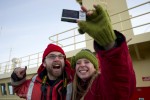
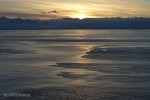
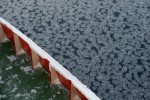
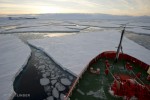
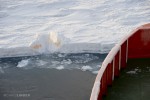








10 Responses to “Saying Hello and Goodbye at the Same Time”